Hello Students, Welcome to your most trusted online learning space. Now, we are presenting to you detailed notes of Chapter-1 ‘Development’ of Economics for Class 10. These notes are prepared keeping in mind the need of students to understand complex concepts in simple language. Moreover, we have some Frequently Asked Questions related to the chapter in which we have put explanation of such concepts which are rarely taught students. And above all, you get latest data regarding development comparison of states and countries according to United Nations, World Bank and Indian Government.
Hope You will enjoy these notes. We will soon give you interactive learning material like quiz, book of mind maps, solution of past year papers, e-books on our website. Stay connected with us. Thank You
Three Questions
Let’s start with three questions:
Q.1 As per World Development Report-2024, what was per capita Income of India in 2023?
Q.2 Do you know the formula for measuring Body Mass Index?
Q.3 Who were the two economists two who collaborated with United Nations Development Program (UNDP) to publish the first Human Development Report?
If you don’t know answers of above questions, these notes are here to help you. Read the notes carefully and you can give answers in the comment section.
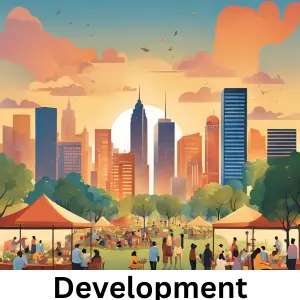
Meaning of Development
It means positive changes in factors which enhance standard of living and quality of life for human beings.
A special Note: You should keep in mind that development is not just the economic growth which solely depends upon growth in income or production of goods and services. It is a broader concept than economic growth.
Developmental Goals
Different people – different goals
Different people can have different developmental goals. A daily wager may have developmental goal that he should get higher wages while a landlord may want that he gets higher Minimum Support Price (MSP) for his crops in the market.
Why Different People have Different Goals?
Different people have different goals because their life situations are different. We can observe this in our society that a daily wager and a landlord have different life situations. They have different allocation of wealth. They have disparities in their income. So, they may have difference in their developmental aspirations.
Conflicting Goals
Apart from different goals, different people can also have conflicting goals. It means that developmental goals of a person may be in direct conflict with the development goals of other person. Example – An agricultural labour may want higher wages from the landlord as a development goal whereas the landlord may want to have cheap labour on lower wages as a development goal to maximize his profit. In this way, their development goals are contrasting to each other.
Mix Goals
Additionally, people may have mix of goals. A person does not have a single developmental goal. He has mix of goals. Example – A daily wager may have development goals like higher wages, regular work, better education for his children, respect in the society etc.
Another Classification of Development Goals
Apart from above developmental goals, they can also be classified into Material and Non-Material Development Goals.
Material Development Goals
Material goals are related to those goals which can be achieved by the use of money like a big house, admission in a costly school, TV, laptops, cars etc.
Non-Material Development Goals
Non-material goals are such types of goals which may not directly depend upon level of Income. They can be – equal treatment, freedom, security, respect of others in the society, true friendship etc.
Which developmental goals are more important?
Importance of material and non-material goals depends upon the different situations in the life of a person. At one time, more important developmental goal for person may be increase in the income while at other times, this may not be the case. We can understand this by the example of Sh. Bhimrao Ambedkar, the architect of Indian Constitution. He was not a poor man. He had enough money for himself and his family. But for him the main developmental goal was the elimination of social discrimination from the society which he himself had faced.
Another Example: Suppose, there is person named Mohan who has a family of six to support. In his family, there are his parents, his wife, one daughter and son. He gets job offers from two companies, Company A and Company B. Company A is offering him Rs. 50000/- per month with regular employment. This company is nearly 20 kms far away from his home. Company B is offering him Rs. 75000/- per month but does not guarantee for regular employment. Moreover, this company is nearly 1500 kms from his house. In this case Company B is offering him Rs. 25000/- more than the Company A. But, he still may choose working in Company A due to considerations of Regular Employment, Distance from his house, safety and security of his family at the new place, looking after his parents in their old age etc.
Table 1 – Developmental Goals for various kind of persons
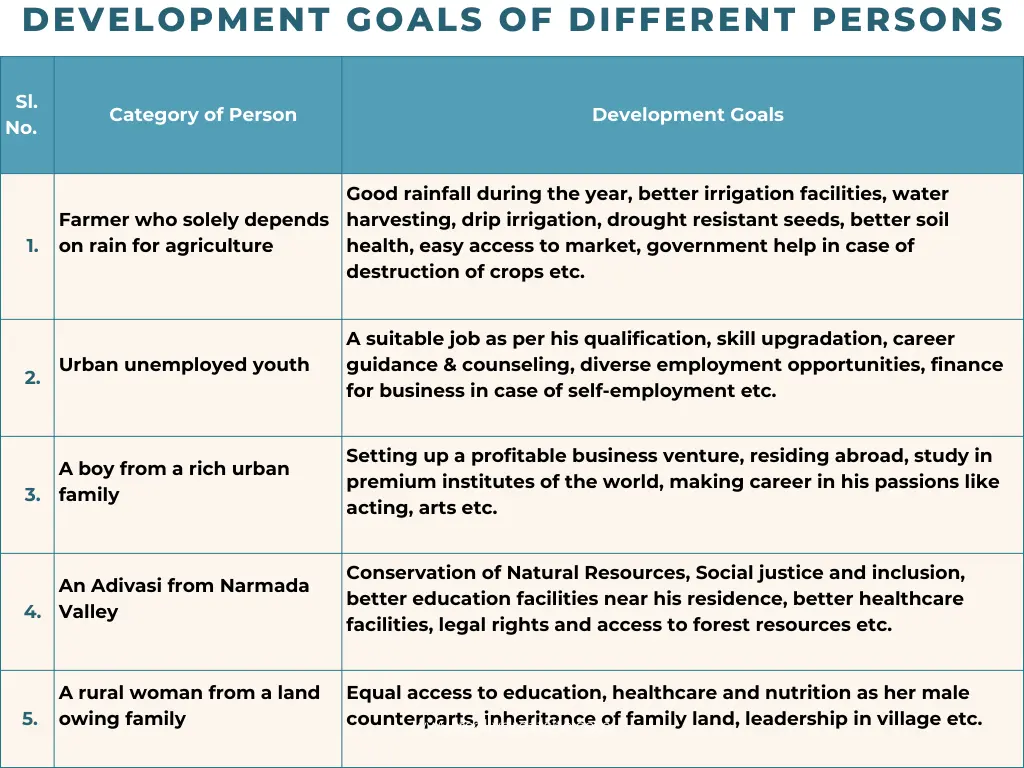
National Development
Since people have different and conflicting goals, there could be different and conflicting notions regarding National Development.
Following are some questions which are considers in the concept of National Development:
1. Can all the ideas or notions of development be considered equally important.
2. If there are conflict in ideas of national development, how the fair and right path of development in decided.
3. What is better way of doing things?
4. Whether a developmental idea benefits a large number of people or a small section of society.
Definition of National Development
National Development may be defined as a process of development of a country in which contrasting and conflicting development goals of different sections of the society are adjusted in such a way that welfare of all sections of the society is assured and no one is left behind in the process of development.
Comparison of Different Countries or States
Different countries or states can be compared on different criteria. Main criteria for development are:
1. Income Criterion
2. Health Criterion
3. Educational Criterion
In most of the development indexes, Income criterion prominently appears because it is considered as one of the most important criteria. Generally, countries or states with higher income are considered more developed. Moreover, through higher income, most of the things of human needs can be purchased. Higher income can also facilitate development of health and educational facilities. It can also give access to these facilities for overall development of human beings.
In Income criteria, two concepts are most important:
1. National Income – Total income of a counties/sum total of income of all the people of a country.
2. Average Income – It is Per Capita Income (PPI) of a country which means income of a person in a country on an average. It is calculated by dividing the total income of a country by its total population.
Generally, National Income is not preferred as a useful measure of development due to following reasons:
1. Different countries have different populations.
2. Total Income does not tell us about the normal income status of a person within a country.
In Contrast to National Income, Average Income solves the above problems, making it more useful measure of development.
Limitations of Average Income as measure of Development:
Though Average Income is a better measure of development than the National Income, it has some serious limitations which are as below:
1. Hides Income Disparities – Average Income does not tell us about the distribution of income amongst citizen of a country. Income Distribution may be equal or unequal, but average income does not tell us about this inequality
2. Non-Monetary Factors: Average Income does not tell us about the status of non-monetary factors of development such as level of education and health facilities, social equality and environment quality etc.
3. Quality of Life: High average income may be misleading if we want measure quality of life. Average Income does not tell us about factor influencing quality of life such as safety & security, discrimination free society, social equality etc.
In 10th Class, Question of Income Disparity is very Important. So, now we will learn about this.
Average Income hides Income Disparities
Average Income does not tell us about distribution of Income in an area. It may be that some people are very rich while most of the people are very poor. Still, average income can be fairly high due to very high individual income of some people. We can understand it though an example:
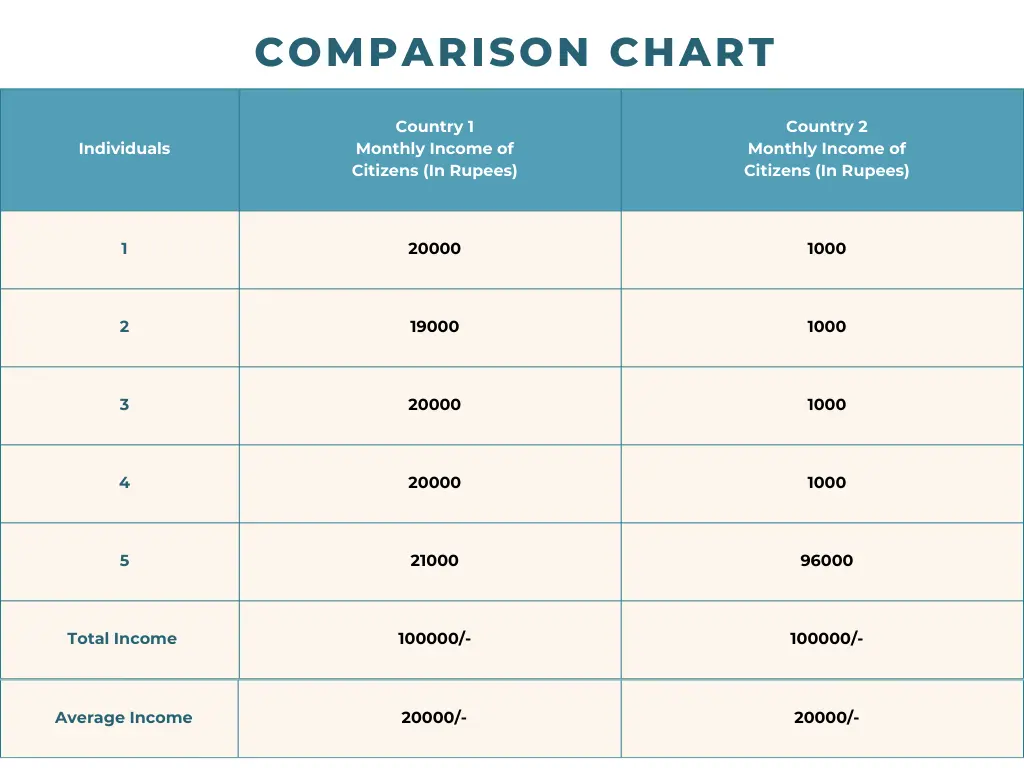
In the above table, we can see that average income of Country A and Country B is Rs. 20000/-. However, in Country A, individual income of the citizen in quite near to Average Income of the country and its National Income is equally distributed among its citizens.
Country B also has Average Income of Rs. 20000/-. However, most of the citizens have individual income far less than the average income and only one individual has higher income than the national average income. If the fifth Individual is not considered for computation of average income, then the average income would be only Rs. 1000/- which is far less than the average income of Country A. So, in country B, maximum portion of National Income is in the hand of just one person.
In this way, we can say that by simply looking at average income of a country, we cannot know the income disparities within that country. As such, Average Income hides income disparities.
Comparison of States based on Various Indicators:
Average Income cannot be sole criteria for development. We can understand this more with the help of comparing three states of India bases on various indicators:
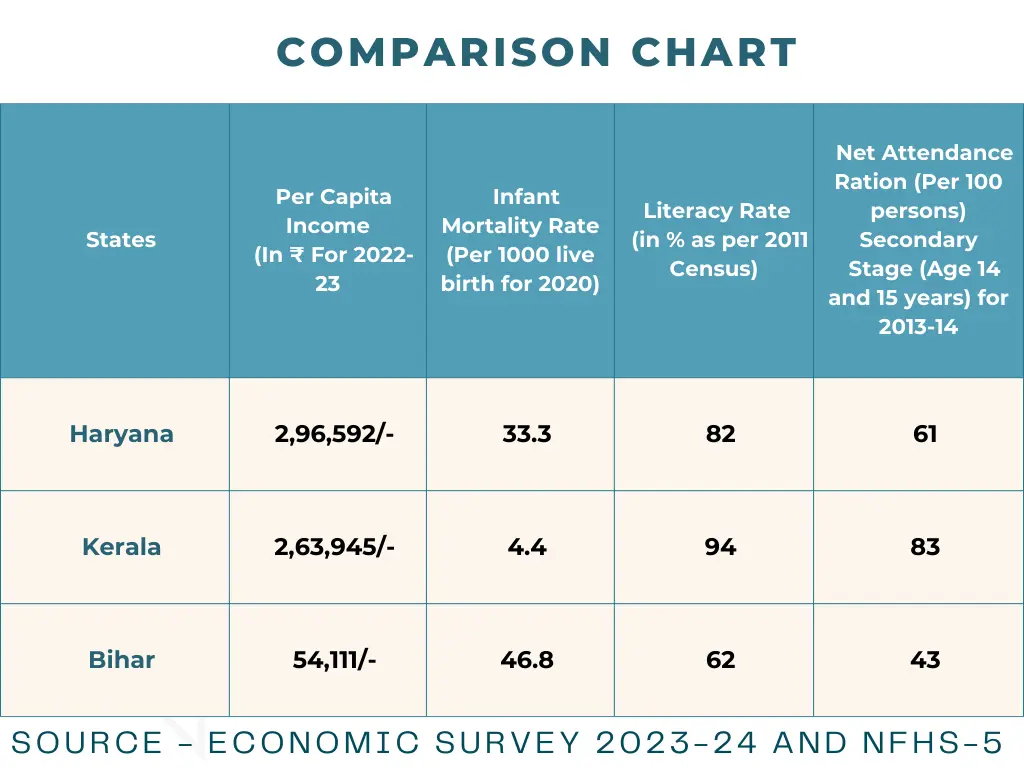
In the above data, we can clearly see that Haryana has highest Per Capita Income among three states. However, it lags behind Kerala in other three developmental indicators which are related to Health and Education. It means that we cannot declare Haryana more developed than Kerala solely on the basis on higher per capital income. When we consider all the indicators of development, we find that Kerala is the most developed state while Bihar is least developed state.
Comparison of countries by World Bank
World Bank publishes World Development Report annually. In this report, it compares countries based on their average income which is measured in US Dollar and is based on Gross National Income (GNI). The categorization as per 2023 Per Capita Income categories:
1 Low-Income Economies – Equal or below US$ 1145
2 Lower Middle Income Economies – US$ 1146 to US$ 4515
3 Higher Middle Income Economies – US$4516 to US$14005
4 High Income Economies – US$14006 and more
India’s per capital income was US$ 2,540 in 2023 as per latest World Development Report-2024. As such, India is placed in the category of Lower-Middle Income Economies.
It should be noted here that World Bank does not classify countries into ‘Developed’ and ‘Developing’ countries. However, most of the high income countries excluding countries of Middle East (West Asia) and some other small countries, are considered Developed Countries. Among these countries, most are from North America and Europe like USA, UK etc.
Comparison by United Nations
Now we will compare India with its neghbouring countries in HDI.
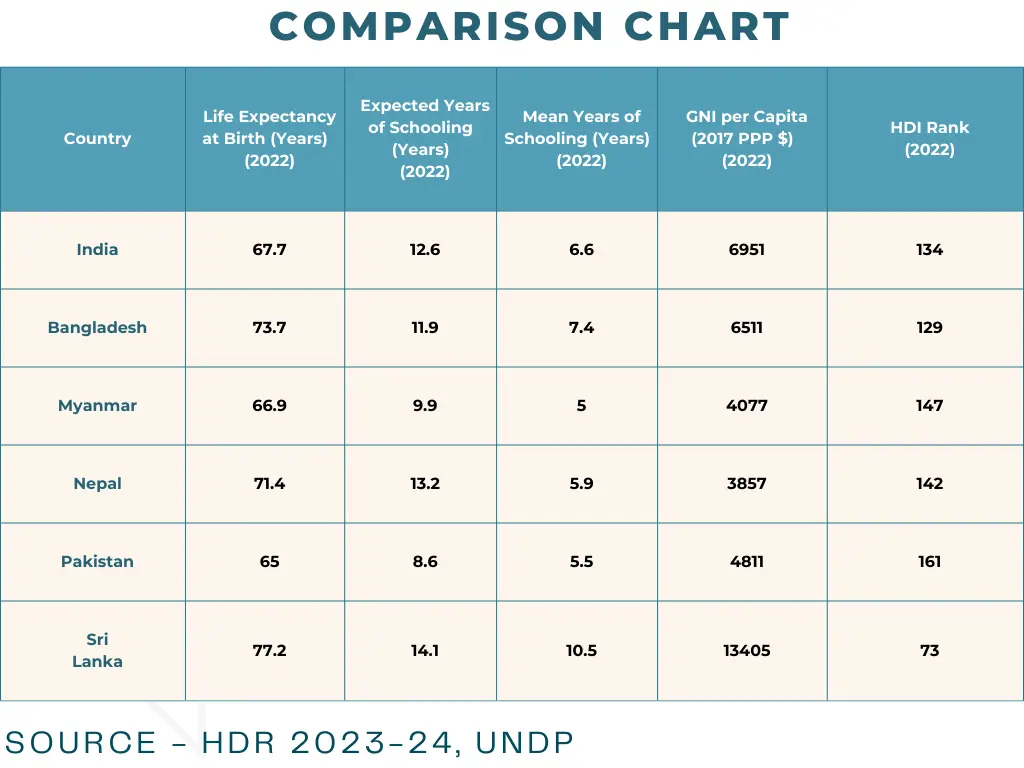
Brief analysis of above data:
Though India is biggest country amongst the above mentioned countries, it is the small island nation Sri Lanka which has best development record. India even ranks behind Bangladesh. However, it fairs better than other neighboring countries like Myanmar and Pakistan. Even Nepal has better Life Expectancy at birth than India.
Public Facilities:
Public facilities are those facilities which can be collectively used by the citizens. They are mainly provided by the government. However, private sector can also provide such facilities. Ex. School, Hospitals, roads, train etc.
Why we need Public Facilities
We need public facilities due to following reasons:
1. Money cannot buy everything: Not all the citizen can buy enough goods and services at market rate to live their life well.
2. Pollution Free Environment: Most of the people, even the rich, may not be able to live in a pollution free environment. So, many facilities like parks are targeted to provide pollution free environment to people.
3. Equal access by all: These facilities are required for equal access by the citizens to certain facilities which they normally cannot afford.
4. Economics Growth: Facilities like road, rails, ports etc. are necessary for economic growth of the country.
Sustainability of development
It is a burning issue in today’s world where traditional resources are depleting at a very fast pace. Off late, the world has paid its attention towards sustainable development to save its resources especially natural resources like portable water, oil, coal, fresh air for future times.
What is Sustainable Development:
It can be defined as a process of development in which present generation uses available resources for its development in such a way that future generations can also use the same resources for their own development.
The idea behind sustainable development is to save resources for our coming generations so that process of development can run smoothly without lack of resources especially of natural resources.
However, it has been estimated that some of the natural resources like crude oil may deplete in few years. Crude oil reserves are expected to last only for 50 more years if we keep using them at present pace. For India, the situation is worse as it meets its most of crude oil requirements through imports. Depletion of crude oil reserve will lead rise in its prices which would result in problem of inflation in countries like India where many industries/sectors like agriculture still heavily depends upon crude oil for their energy requirement.
Body Mass Index
It is a health indicator which depends on the weight and height of person as per his age. It can be calculated by the following formula:
BMI = Weight (kg) / Height (m)²
Frequently Asked Questions (FAQs)
Q. 1 What is the actual name of World Bank?
Ans: The actual name of the World Bank is the International Bank for Reconstruction and Development (IBRD). It is one of the institutions in World Bank Group along with other institutions like International Development Association (IDA), International Finance Corporation (IFC), Multilateral Investment Guarantee Agency (MIGA), and International Centre for Settlement of Investment Disputes (ICSID).
Q.2 Are GDP and GNI same concept?
Ans: No, they are not the same concepts. Gross Domestic Product (GDP) is related to domestic product/income generated within the domestic territory of country. On the other hand, Gross National Income (GNI) is related to national product which can be calculated by adding Net Factor Income From Abroad into GDP. So, GNI is a broader concept than GDP.
Q.3 What is Infant Mortality Rate?
Ans: It tells the number of children who die before the age of one year as a proportion of 1000 live birth in that particular year. Suppose there are 1000 live births in a country during a year and 40 children die before the age of one year, then IMR is 40 per 1000.
Q.4 What is Literacy Rate?
Ans: Literacy rate is the proportion of literate populations in the 7 and above age group. Suppose, India’s population was 120 crores in 2011. Out of the 120 crores, 100 crores people were of 7 and above age group. Literacy rate is the percentage of literate population out of this 100 crore. Now, suppose 75 crores people are literate out this 100 crore population. Then literacy rate of India would be 75%.
Q. 5 Who is considered a literate person in India?
Ans: As per Census of India, a literate person is that person who can read, write and understand a simple sentence in any language spoken in India.
Q. 6 What is Net Attendance Ratio (NAR)?
Ans: Net Attendance Ration is number of children in a specific age group attending school as a percentage of total number of children in the same age group. Suppose, there are 10 crore children in the age group of 14-15 years. Out of these, 8 crores children are actually attending the school. Then NAR for this age group would be 80%.
Q.7 What is Life Expectancy at birth?
Ans: It is the average expected length of life of a person at the time of birth. In this concept, age specific mortality rates are taken constant. If age specific death rates fall in the future, life expectancy can increase.
Q.8 What is Purchasing Power Parity (PPP) in US Dollar?
Ans: PPP is a concept in which currency of one country is converted into the currency of another country in such a way that it will buy same amount of goods and services in each country. For example, if a burger cost Rs. 40 in India while it costs USD 1 in USA, then the PPP rate of USD and Rupee is 1:40. This rate is very much different from the market exchange rate of USD for Rupee. Many institutions like UNDP, converts currencies of different countries into US dollar for comparison. For determining PPP rates, national average prices of a basket of around 1000 products are considered.
Q.9 When and who published first Human Development Report?
Ans. First HDR was published in 1990. It was launched by Pakistani economist Mahbub ul Haq and Indian Nobel laureate Amartya Sen in collaboration with United Nations Development Program.

IT WAS HELPFUL FOR ME